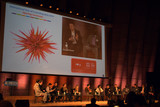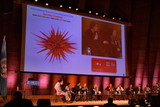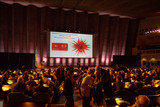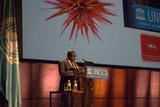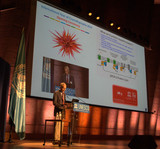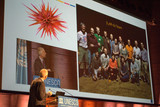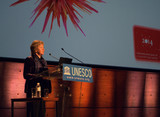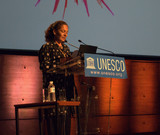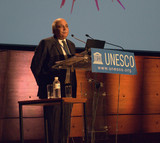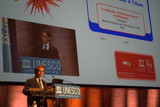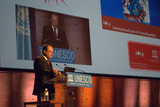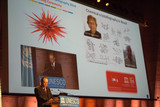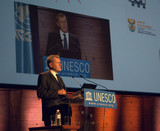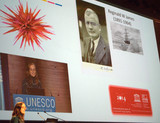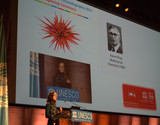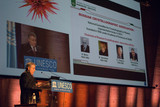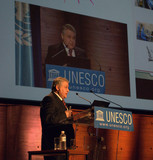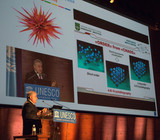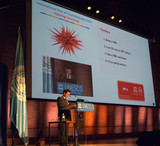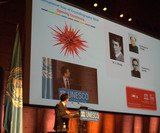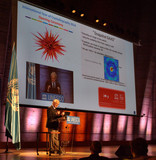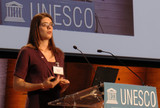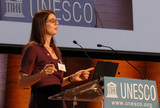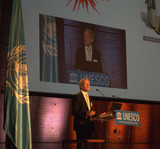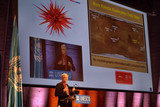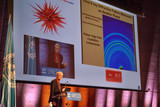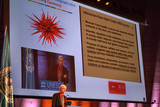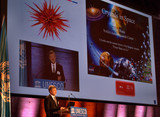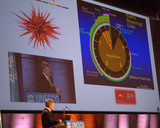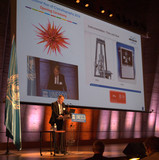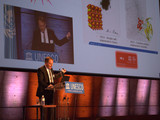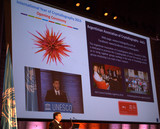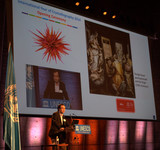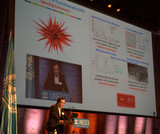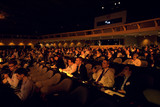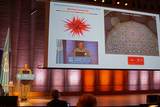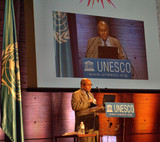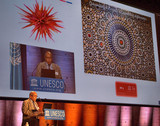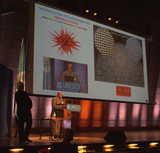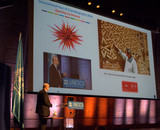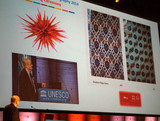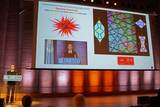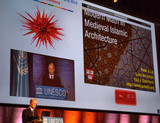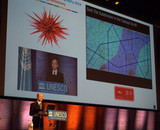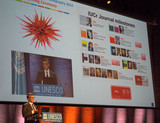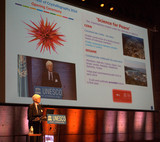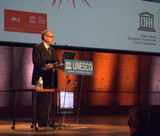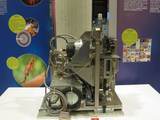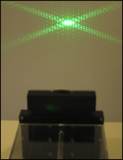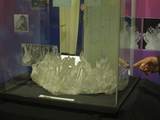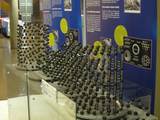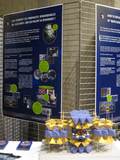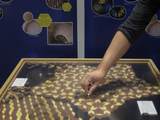IYCr 2014 Opening Ceremony
UNESCO, Paris, France
20 - 21 January 2014
More than 800 people attended the opening ceremony which launched the International Year of Crystallography at UNESCO on 20 and 21 January 2014. Government representatives, scientists and journalists featured among the participants. The Year is being coordinated jointly by UNESCO and the International Union of Crystallography.
Question and answer session.
Young Crystallographers Session
Question and answer session.
Young Crystallographers Session
Participants in the 'Young crystallographers' panel. Front row: Adriana Serquis, Ji-Joon Song, Marcin Nowotny, Yvon Bibila, Anders Madsen, Mohamed Eddaoudi, Rumana Akther Jahan.
Back row (from left): Malla Reddy, Rahul Banerjee, Philip Ball.
Young Crystallographers Session
Introductory remarks by Jules Tenon.
Nobel Laureate Lecture
Brian Kobilka, 2012 Nobel Laureate in Chemistry, speaking about 'Structural insights into G-protein-coupled receptor signalling'.
Nobel Laureate Lecture
Brian Kobilka.
Nobel Laureate Lecture
Summary remarks by Judith Howard.
Nobel Laureate Lecture
Crystallography in Emerging Nations Session
Vinay Sheel Oberoi, Ambassador, Permanent Delegate of India to UNESCO.
Crystallography in Emerging Nations Session
Thirumalachari Ramasami, Secretary, Department of Science and Technology, Government of India.
Crystallography in Emerging Nations Session
Glaucius Oliva, President, Brazilian National Council for Scientific and Technological Development (CNPq).
Crystallography in Emerging Nations Session
Glaucius Oliva.
Crystallography in Emerging Nations Session
Thomas Auf der Hyde, Deputy Director-General, South African national Department of Science and Technology.
Crystallography in Emerging Nations Session
Catherine Esterhuysen, President, South African Crystallographic Society.
Crystallography in Emerging Nations Session
Catherine Esterhuysen.
Crystallography in Emerging Nations Session
Mikhail Kovalchuk, Director of the Kurchatov Institute and Chair of the National Russian Crystallography Committee.
Crystallography in Emerging Nations Session
Mikhail Kovalchuk.
Crystallography in Emerging Nations Session
Mikhail Kovalchuk.
Crystallography in Emerging Nations Session
Gao Song, President, Chinese Crystallographic Association.
Crystallography in Emerging Nations Session
Gao Song.
Crystallography in Emerging Nations Session
John Spence: 'From X-ray tube to X-ray lasers'
Crystallography for Society and the Future
Juliette Pradon: 'Crystallographic research in the developing world'.
Crystallography for Society and the Future
Juliette Pradon.
Crystallography for Society and the Future
Martijn Fransen: 'Crystallography in our daily lives'.
Crystallography for Society and the Future
Martijn Fransen.
Crystallography for Society and the Future
David Bish: 'Crystallography in the study of the Universe'.
Crystallography for Society and the Future
David Bish: the first X-ray diffraction pattern measured on another planet.
Crystallography for Society and the Future
David Bish.
Crystallography for Society and the Future
David Blake: 'Crystals in Space'.
Crystallography for Society and the Future
David Blake.
Crystallography for Society and the Future
Frank Burgäzy: 'A short history of crystallographic technology'.
Crystallography for Society and the Future
Frank Burgäzy.
Crystallography for Society and the Future
Diego Lamas.
Crystallography for Society and the Future
Philippe Walter: 'Crystallography in the study of art and historical artefacts'.
Crystallography for Society and the Future
Philippe Walter.
Crystallography for Society and the Future
Crystallography for Society and the Future
Abdelmalek Thalal on 'Symmetry in art and architecture of the western Islamic Golden Age'.
Crystallography, Symmetry and Art
Abdelmalek Thalal.
Crystallography, Symmetry and Art
Abdelmalek Thalal.
Crystallography, Symmetry and Art
Abdelmalek Thalal.
Crystallography, Symmetry and Art
Emil Mackovicky on 'Highlights of eastern Islamic ornamental arts as seen through crystallographers' eyes'.
Crystallography, Symmetry and Art
Emil Mackovicky.
Crystallography, Symmetry and Art
Peter Lu on 'Modern math in medieval Islamic architecture'.
Crystallography, Symmetry and Art
Peter Lu.
Crystallography, Symmetry and Art
Peter Lu.
Crystallography, Symmetry and Art
Samar Hasnain; ' IUCrJ and crystallography working across nations'.
Crystallography and Peace
Chris Llewellyn Smith: 'SESAME: fostering science, building bridges'.
Crystallography and Peace
Maciej Nalecz.
Closing Remarks
The structure of molecules of biological importance can be worked out with synchrotron radiation, using devices like the one that was used at the European Synchrotron Radiation Facility by Nobel Prizewinner Brian Kobilka.
Exhibition
The demonstration of laser light diffracted by the fine mesh of a sieve demonstrates how X-rays diffract off the much smaller layers of atoms in a crystal.
Exhibition
Mankind's fascination with crystals was stimulated by the discovery of naturally occuring clusters of rock crystal (quartz).
Exhibition
The mystery of why diamonds sparkle, why they are so hard and yet can burn like coal was solved ultimately by the understanding of its structure that crystallography provided. This display shows models of the structures of diamond, graphite, fullerenes, nanotubes and graphene - all forms of pure carbon.
Exhibition
There are many applications of crystallography and the understanding of crystal structure in our daily lives, that help us to understand the world in all its diversity. This model shows the structure of Maya Blue, a unique azure blue pigment from pre-Columbian America.
Exhibition
This interactive model demonstrates how to tile a plane surface with local fivefold symmetry. Similar local symmetry in three dimensions is found in quasicrystals, materials that exhibit fivefold or tenfold symmetries in their structure that were once believed to be impossible.
Exhibition



